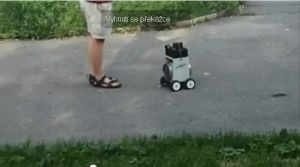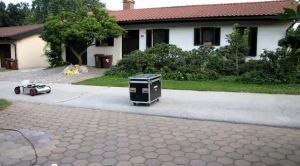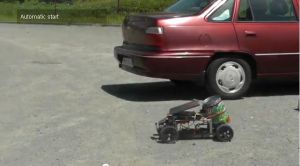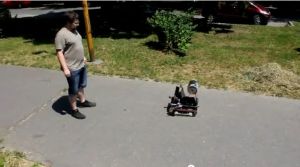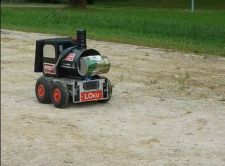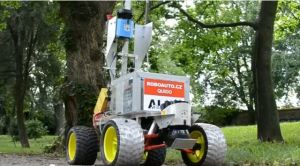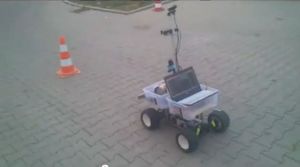Introduction of teams
this time with YouTube videos
Robotour is returning back to it's origin this year: Prague, park Stromovka. The contest will be probably in unexplored parts of the park, but the base camp will be the same as in years 2006-2008: in Planetárium Praha. And who is coming? If all 12 teams, which sent homologation video, will come, we will see (besides home teams) also representatives from Austria, Slovenia, Slovakia, Switzerland and Russia.
ARBot
ARBot is a small robotic vehicle constructed for outdoor competitions of
autonomous robots. The robot has 4-wheel chassis, where all wheels are driven
and equipped with encoders. Robot has camera, GPS, AHRS unit and three
sonars. DSP BF537 (on 1000 MIPS) takes care of all computations. Image
segmentation, based on learing with a teacher and MSRC database, was
significantly speeded up and improved for this year. New non-linear regulation
algorithm allows faster speed while keeping precision and quality of
control. New is also local map of robot environment and localisation
algorithm.
Cogito
Platform: RC model 1:5 with electromotor.
Processing power: Arduino Duemilanove (low-level control) + Gumstix Overo
Fire (higher level control)
Sensors set: IP camera, Asus Xtion Pro (3D depth sensor),
sonars, accelerometers, gyroscopes, magnetic compass, magnetic encoder.
Software: Focus on road and obstacle detection, research in global localisation area.
The Experts
youtube http://youtu.be/S2QiXHsHbZQ
Our robot is based on multifunctional homebuild robot platform. We
wanted to make tank-like drive, but used motors were too weak for
this, so we added two rotary wheels. On the platform we have portable
computer, which takes care of all the computing. The software is
written in C#. At the moment we are using Kinect 3D sensor for road
recognition, but it’s not working well in sunshine, so we are planning to
replace it with IP industrial camera and 2D SICK lidar sensor. Hope we
make it working till competition.
[FAIL]
Name of our robot is OLAV. The base structure consists of a modified 1:10
RC-car and a mounted aluminium box, serving as a safe haven for main
electronic and payload carrier. The electronic system is splitted in two parts.
First part is a Controller Area Network (CAN-BUS) which consists of uController
controlled nodes, which handle the basic functions (motor, servo, lights, …).
Second part is a mini- ITX board (D525MW), which is able to communicate with the
CAN-BUS, runs the "brain" of the robot and handles the USB-cam and image
processing. The CAN nodes are programmed in C and the mini-ITX runs a Debian
distro.
Plecharts
Robot is built on a 1:5 scale RC car. All computations run on
onboard notebook, connected with various sensors using an I2C bus. The robot
tries to stay on road using a webcamera, which will probably not be integrated with any kind of mapping software, so it will drive itself only using a method
called "All ways lead to Rome".
Protos Team
(CANCELED)
We use 2 arduinos for control and netbook for image processing from camera and
Kinect. Robot has ultrasound sonars, GPS, compass and is powered by li-pol
battery. Robot is relatively slow but can easily handle terrain or hills.
Radioklub Písek
youtube http://youtu.be/h4epM1wi33s
Our robot is based on four wheel chassis, all wheels driven. The power source are
two lead-acid gel accumulators 17Ah/12V. The main sensor for orientation on the
road is laser range finder SICK LM100. Nine axis IMU razor AHRS and GPS
Navilock is then used for direction correction. The whole control program is
written in Python2.6 and runs on Suse linux operating system. We plan new
robot, but we are not sure if it will be ready on time.
Roboauto Karlík
Modified kids car PegPerego with reworked gas control from MAN truck.
We implemented smooth speed control forward and backward, LIDAR for obstacle
detection, inertial unit, GPS, ultrasound sensors in front, magnetic compass,
camera Sony. The power source is car battery 12V. Processing HW – notebook
Hewlett Packard + 100 MBit switch.
Roboauto Quido
Modified model of
RC
car, smooth speed control forward/backward, LIDAR for obstacle avoidance,
inertial unit, GPS, camera, odometer, compass. Processing HW –notebook + 100
MBit switch.
Short Circuits Prague
Robot is based on platform of monster truck model in scale 1:5. The main
processing unit is a standard notebook. Hardware status is monitored via Arduino
Duemilanove board. Sensors equipment: magnetic quadrature encoder, compass,
sonars, Lidar, GPS receiver and camera. Software is written in Python language.
The main program receives all current information about HW status by USB. Low
level info about HW is processed by micro chip ATMEGA328, which prepares packets for
the main program. The main program transforms this low level
info into HW independet structure. It also takes care of PID speed control,
localisation from odometry, GPS and compass, obstacle detection and avoidance
and finally navigation on given track. The robot recognizes the road in front of
the vehicle from camera and lidar data. Obstacles are then detected via sonar
and lidar. Information from these sensors is represented in local map, where
Vector Field Histogram methods searches for new path.
Siners
4-wheel autonomous robot, equiped with 7 infrared distance sensors,
GPS, web-cam, microcontroller and PC.
Smely Zajko
List of parts: Parallax (Motor Mount and Wheel Kit), encoders, 2xHB25,
Sbot board (AVR ATmega128),
PC ASUS UL30V,
5x SRF-08,
GPS NaviLock NL-302U USB SiRF III,
Compass with tilt compensation (HMC6343),
AVR ATmega8 (for compass controll),
Camcorder Panasonic SDR-T50,
video grabber AVerMedia DVD EZMaker USB Gold,
red power switch,
USB hub.
Handmade wood & aluminium base,
Power: HAZE HZS 12V 9Ah.
Ubuntu Linux, mplayer, plink, custom C++ code.
If you would like to support our contest or do you have some extra info/query,
please let us know via contact form.
